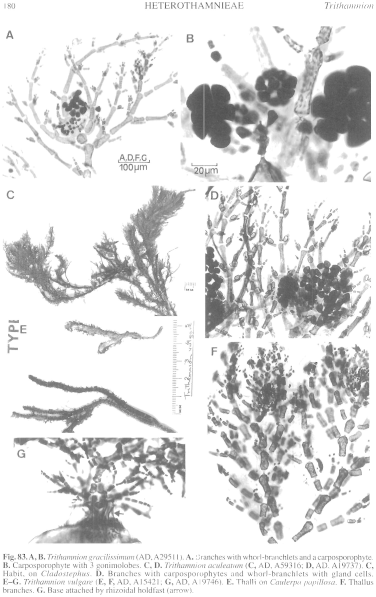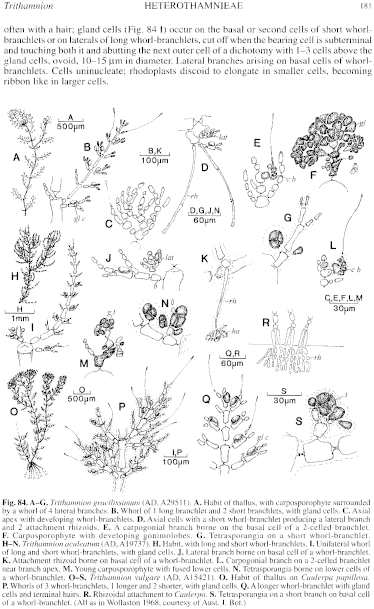|
|
|
|
|
|||||||||||
|
Electronic Flora of South Australia Species Fact Sheet
Phylum Rhodophyta – Order Ceramiales – Family Ceramiaceae – Tribe Heterothamnieae
Selected citations: Athanasiadis 1996: 101.
Thallus (Figs 83E, 84O) erect, 2–4 (–7) mm high, with clumps of erect axes, each axial cell with 3 upwardly curved whorl-branchlets (Fig. 83F) unilaterally placed (within 180°) and rotated on successive axial cells, the central whorl-branchlet slightly longer than the other two. Attachment by branched, clumped, rhizoids forming a distinct holdfast (Fig. 83G) 50–200 µm across, arising from the basal cells of erect axes (Fig. 84R); epiphytic on Caulerpa spp. and other firm-surfaced algae. Structure. Apical cells 4–6 µm in diameter and L/D 1–2, within clusters of lateral whorl-branchlets of small branched cells, then enlarging rapidly to axial cells 30–100 µm in diameter and L/D 1–2.5, with thick walls and the contents slightly greater in diameter at their upper end. Longer whorl-branchlets 200–320 µm and 6–8 cells long, longest centrally on the axes, each rachis cell with usually more or less opposite branches 1–3 cells long (Fig. 84P), usually terminating in a pair of small terminal cells often with hairs (Fig. 84Q); shorter whorl-branchlets 100–250 µm long, with fewer pairs of branches; rachis cells basally unbranched and usually shorter than outer cells, 30–40 µm in diameter and L/D 1.5–2, tapering to terminal and lateral cells 7–10 µm in diameter and L/D 1–1.5; gland cells usually frequent and prominent (Fig. 84Q), borne on basal to mid cells of whorl-branchlets, touching the bearing cell and abutting one of the pair of terminal cells, ovoid, 15–22 µm in diameter. Lateral branches replacing longer whorl-branchlets. Cells uninucleate; rhodoplasts discoid in smaller cells, elongate to ribbon like in larger cells.
Reproduction: Gametophytes unknown.
Tetrasporangia borne (Fig. 84S) on special short branches on the basal cells of whorl-branchlets, sessile, subspherical to slightly ovoid, 15–25 µm in diameter, tetrahedrally divided.
Type from D'Estrees Bay, Kangaroo I., S. Aust., on Caulerpa papillosa (Womersley, 24.viii.1950); holotype and isotypes in AD, A15421.
Selected specimens: Pearson I., S. Aust., on Pterocladia capillacea, upper sublittoral (Specht, 17.0.1960; AD, A24526). Brighton, S. Aust., on Pachydictyon paniculatum, drift (Bienert, 12.xi.1965; AD, A29676). Pennington Bay, Kangaroo I., S. Aust., on Caulerpa papillosa, drift (Womersley, 22.viii.1954; AD, A19746). Bridgewater Bay, Vic., on Caulerpa hrownii in pools (Womersley, 28.i.1964; AD, A27431). Lawrence Rock, Portland, Vic., on Caulerpa hrownii in pools (Beauglehole, 13.i.1954; AD, A20520). Bicheno, Tas., on Caulerpa flexilis, 0–5 m deep (Olsen, 29.xii.1963; AD, A27065).
Distribution: Pearson I., S. Aust., to Lawrence Rock, Vic., and E Tasmania.
Taxonomic notes: T. vulgare is characterised by the habit and branching, cell sizes, and especially by the holdfast of clumped, elongate, rhizoids from the basal cells of erect axes.
References:
ATHANASIADIS, A. (1996). Morphology and classification of the Ceramioideae (Rhodophyta) based on phylogenetic principles. Opera Botanica No. 128, pp. 1–216.
WOLLASTON, E.M. (1968).Morphology and taxonomy of southern Australian genera of Crouanieae Schmitz (Ceramiaceae, Rhodophyta). Aust. J. Bot. 16, 217–417.
The Marine Benthic Flora of Southern Australia Part IIIC complete list of references.
Publication:
Womersley, H.B.S. (24 December, 1998)
The Marine Benthic Flora of Southern Australia
Rhodophyta. Part IIIC. Ceramiales – Ceramiaceae, Dasyaceae
©State Herbarium of South Australia, Government of South Australia
Illustrations in Womersley Part IIIA, 1998: FIGS 83 E–G, 84 O–S.

Figure 83 enlarge
Fig. 83. A, B. Trithamnion gracilissimum (AD, A29511). A. Branches with whorl-branchlets and a carposporophyte. B. Carposporophyte with 3 gonimolobes. C, D. Trithamnion aculeatum (C, AD, A59316; D, AD, A19737). C, Habit, on Cladostephus. D. Branches with carposporophytes and whorl-branchlets with gland cells. E–G. Trithamnion vulgare (E, F, AD, A15421; G, AD, A19746). E. Thalli on Caulerpa pupillosa. F. Thallus branches. G. Base attached by rhizoidal holdfast (arrow).

Figure 84 enlarge
Fig. 84. A–G. Trithamnion gracilissimum (AD, A29511). A. Habit of thallus, with carposporophyte surrounded by a whorl of 4 lateral branches. B. Whorl of 1 long branchlet and 2 short branchlets, with gland cells. C. Axial apex with developing whorl-branchlets. D. Axial cells with a short whorl-branchlet producing a lateral branch and 2 attachment rhizoids. E. A carpogonial branch borne on the basal cell of a 2-celled branchlet. F. Carposporophyte with developing gonimolobes. G. Tetrasporangia on a short whorl-branchlet. H–N. Trithamnion aculeatum (AD, A 19737). H. Habit, with long and short whorl-branchlets. I. Unilateral whorl of long and short whorl-branchlets, with gland cells. J. Lateral branch borne on basal cell of a whorl-branchlet. K. Attachment rhizoid borne on basal cell of a whorl-branchlet. L. Carpogonial branch on a 2-celled branchlet near branch apex. M. Young carposporophyte with fused lower cells. N. Tetrasporangia borne on lower cells of a whorl-branchlet. O–S. Trithamnion vulgare (AD, A15421). O. Habit of thallus on Caulerpa papillosa. P. Whorls of 3 whorl-branchlets, 1 longer and 2 shorter, with gland cells. Q. A longer whorl-branchlet with gland cells and terminal hairs. R. Rhizoidal attachment to Caulerpa. S. Tetrasporangia on a short branch on basal cell of a whorl-branchlet. (All as in Wollaston 1968, courtesy of Aust. J. Bot.)

|
Email Contact: State Herbarium of South Australia |

|